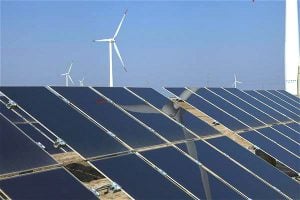As delegates continue tense talks over drafts in Paris, a group of Chinese cadres, city mayors and advisors, are feeling more relaxed. They are in Paris on a mission, to make the abstract idea of China’s 2030 carbon peak a reality, and to give the world a glimpse at the tools China will use to get there.
At the first US-China Climate-Smart and Low-Carbon Cities Summit, held in September this year, nine Chinese cities announced they would reach peak carbon ahead of the national target of 2030. They included the major cities of Beijing, Guangzhou and Shenzhen; the medium-sized Zhenjiang, Jilin City and Guiyang; and even Yan’an and Jinchang, both undeveloped cities. Beijing, Guangzhou and Zhenjiang plan for carbon emissions to peak and start to fall around 2020 – a whole decade earlier than the national target.
According to figures from the Energy Foundation’s Innovative Green Development Program, these cities cumulatively accounted for 10.3% of national GDP in 2013 (or the size of Mexico’s economy), and 3.3% of China’s total population (about the size of Colombia).
The National Development and Reform Commission has set targets for an early carbon peak in 35 cities that together account for half the output of China’s entire economy.
China’s route to peak carbon is in some ways similar to its route to economic reform – some people will go on ahead, finding the way as they go. As Zhenjiang’s mayor Zhu Xiaoming said in Paris this week: “When we became a low-carbon trial city in November 2012, our first task was to achieve a carbon peak, and this is also what NDRC [The National Development and Reform Commission] told us [to do].” And Zhenjiang’s experience offers a roadmap of the route China as a whole may take.
Not many outside of China will have heard of Zhenjiang, a city of three million people on the lower reaches of the Yangtze River in Jiangsu province. But the choices it faces on its way to becoming a low carbon city are representative of many cities in eastern China, with rapidly growing economies reliant on the manufacture of building materials, metals and chemicals. Reaching peak carbon faster than the country as a whole will involve decoupling growth from increased carbon emissions.
To make that happen quickly, the city set up a carbon statistics system, tracking emissions by company, sector and district. That allowed the calculation of various scenarios. According to Zhu Xiaoming, original policies would have meant peak carbon being reached only in 2038. Energy restructuring could bring that forward to 2027, but a radical economic restructuring, with the city focused on developing its service sector, could mean achieving peak carbon as early as 2018.
This scenario reflects the choices many local policymakers are faced with. In the long-term they need to decide how to increase the proportion of non-fossil fuel sources in the energy mix and in the short-term how to lighten the economic structure. If heavy industry contributes too much to the local economy, the ability to cut emissions will be curtailed.
The choices local governments make must reflect the diversity of the cities they work in. An official with the NDRC told chinadialogue:
“Zhenjiang was originally an industrial city, giving it plenty of room for economic restructuring and development of the service sector. Cities like Shenzhen and Hangzhou don’t have that option and emissions cuts will need to come from improving the environment and building standards – that means energy-saving buildings and reducing vehicle emissions.”
Data in the public domain shows that in Shenzhen, one of China’s most developed cities, the service sector accounts for 57.3% of the economy. In Zhenjiang industry is more important, and services account for about 45% of all economic activity, meaning it still has a lot of room for improvement.
Zhenjiang predicts that every time 1% of economic activity shifts from industry to the service sector, carbon emissions fall by 1.53%. That outstrips the gains from energy restructuring, where reducing the proportion of coal in the energy mix by 1% cuts emissions by only 0.22%.
Economic restructuring measures have been keenly felt in Zhenjiang. In the last three years, 285 small, inefficient and polluting firms were shut down. New projects were subject to carbon assessments, with checks on potential emissions increases. This shifted development to strategic emerging sectors, such as the manufacture of high-end equipment, new materials and services. Data on profits, tax-take, jobs created and overall economic output have been combined with emissions figures, allowing all of these factors to be considered in planning decisions and policymaking.
As Zhu Xiaoming explained: “We could tell which sectors were able to reduce emissions but still see good growth in profits and taxes paid.”
As well as restructuring its economy, Zhenjiang also implemented what Zhu refers to as carbon auditing “with Chinese characteristics.” The districts of Zhenjiang were given emissions caps and carbon intensity targets, with audits carried out to make sure these were adhered to.
So far, it seems this combination of measures has allowed Zhenjiang to find a rare balance between economic growth and emissions cuts. Figures presented at the UN summit in Paris this week showed high GDP growth in 2014, at 10.9%, and carbon intensity falling 4.9% – meaning the city hit its 12th Five Year Plan emissions target a year early. However certain measures, such as closing down small polluting firms, give impressive but one-off results. Further reductions in other areas of the city’s economy will be more complex and expensive.
In Paris, Zhu Xiaoming agreed: “Money is a big issue… the technology is there, but for us the costs are too high.”
Despite an imminent roll-out of carbon trading in China, the use of markets was not used in Zhenjiang’s case. Trading is regarded as an effective way of reducing the cost of emissions cuts, but Zhenjiang officials explained it was not an option, as local governments cannot put the necessary legislation in place. However, this may be changing. Recently, the city announced it will “implement carbon trading in line with the national roll-out,” which the Chinese government has said will start in 2017.
Similarly, local governments need central government help and authorisation to utilise other badly needed policy tools, such as emission permits for carbon. Without central-level legislation, local governments suffer from a lack of legal basis for many of their carbon reductions measures, especially when it comes to regulating the private sector.
In a 2015 assessment of Zhenjiang’s low-carbon trial project the National Centre for Climate Change Strategy said that “currently the most obvious problem is a lack of legislation”, suggesting that local government measures were often met with passive resistance. It was therefore recommended that design of caps, emissions permits and carbon trading was strengthened at the national level, “to help China reach peak carbon around 2030.”
The question is not can China reach peak carbon in the next fifteen years but which provinces will get there first.







